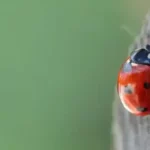If you’re an avid grower, it’s only a matter of time before asking yourself, do ladybugs eat aphids? However, if you’ve already had the unique challenge of trying to manage this pesky and infamous insect and don’t care for using harsh pesticides within your green space, you may have heard that ladybugs may be your saving grace.
Ladybugs are natural predators of aphids, with adult beetles and their larvae feeding on large quantities of aphids throughout their lifecycles. In large numbers, lady beetles can significantly reduce aphid infestations and are a familiar and welcome sight to many gardeners for this very reason. While releasing ladybugs into your garden effectively controls aphid populations, there are essential factors to consider, such as timing and appropriate release rates.
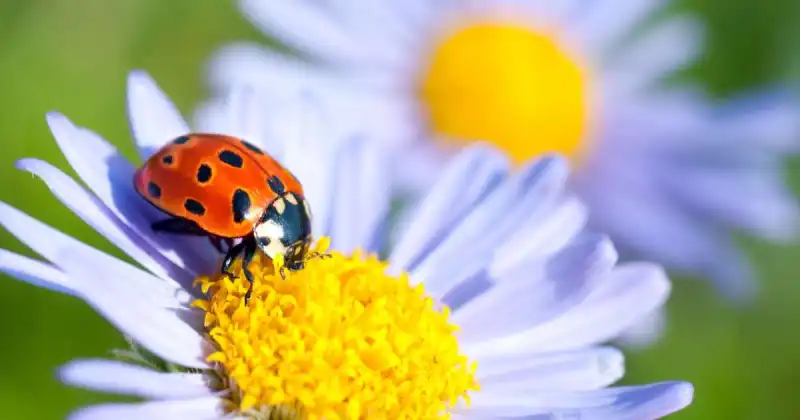
Aphids are considered a common garden pest and pose a unique challenge to vegetable plants. These tiny insects can cause catastrophic damage in gardens, including stunted plant growth, damage to produce, and even spreading viral and bacterial infections that, if left unchecked, can cause plant death throughout your area.
Fortunately, an adequate supply of ladybugs can combat these pests without using harmful chemicals and is just one of many available natural pest control options for gardeners.
In this article, I’ll explore the effectiveness of ladybugs for aphid control, their benefits and drawbacks, and some valuable tips on handling and releasing ladybugs properly. So, without further ado, let’s get you started reclaiming your green space naturally and take back what’s rightfully yours!
Humble Highlights
- Discover why spreading ladybugs in your garden may be the most effective and natural way to fight back against damaging aphid populations so you can fight off pests while preserving the health of your plants.
- Save time by learning the best methods to release ladybugs in your garden AND how to store them effectively for future releases.
- Learn the exact steps to encourage lady beetles to stay in your garden so you can reap the benefit of these speckled critters throughout the season.
Do Ladybugs Eat Aphids
Ladybugs are natural predators of aphids and can eat up to 75 of these troublesome critters daily. Not only do ladybugs eat aphids, but they also feed on other common pests such as whitefly and spider mites.
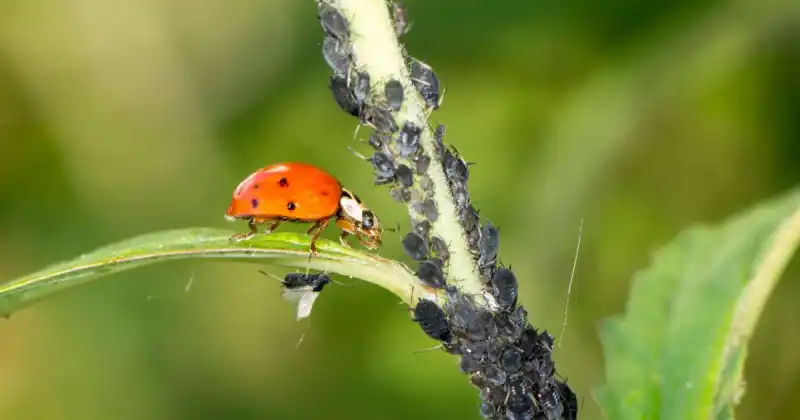
If you are concerned that the ladybugs in your garden may not stay around long enough to eradicate the problem, don’t worry. These colorful friends lay their eggs on the same plants with aphids and other pests, so their larvae can continue to feed. 1
Ladybugs are small, round beetles with brightly colored shells. They are also known as ladybirds or lady beetles, and there are over 5,000 known species of ladybugs worldwide. Moreover, ladybugs can be easily purchased and released in gardens to help control aphid populations, making them a great addition to any garden.
Why Are Aphids Considered Garden Pests
Aphids are a common pest, spoiling crops and causing stunted plant growth and foliage death. Although aphids can appear in your garden anytime, they are common in spring and flourish in cool, wet weather. Although these insects are tiny, their subsequent damage can be extensive as aphids can multiply quickly and feed on the sap of plants, leaving them weakened and vulnerable to disease and decay.
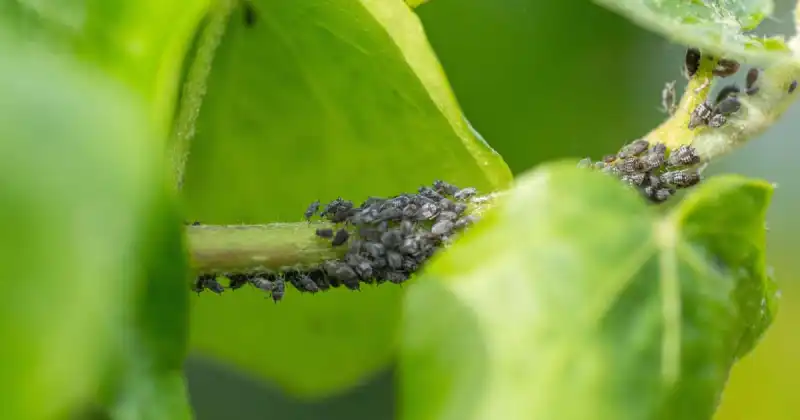
Aphids can also attract additional pests, such as ants and wasps, further damaging your garden’s ecosystem. Additionally, the sticky honeydew these pests deposit on plant leaves can create a breeding ground for harmful fungi or the growth of sooty mold compromising plant health, which can quickly spread throughout your crops. And when infestations grow large enough and remain unchecked, aphids can wreak havoc on any garden, no matter the experience or success of its grower.
Many gardeners use synthetic and chemical pesticides to control aphid colonies that may spring up among your veggies. Although these applications typically do the job after several applications, these products can also target and kill beneficial insects, such as ladybugs, while contaminating nearby soil, rivers, and streams through runoff. 2
Fortunately, natural solutions exist, like introducing ladybugs into your growing area. This practice is a more sustainable and effective way to manage aphid infestations. By understanding the harmful effects of aphids on garden plants, gardeners can proactively and simultaneously protect their gardens and promote a healthy surrounding ecosystem.
Ladybugs Eating Aphids (Just The Facts, Please)
Although ladybugs attack and eat other harmful garden insects, aphids remain their most popular choice. Now that you’ve discovered that ladybugs eat aphids and are a potential solution to controlling aphid infestations, let’s take a quick look at some basic facts.
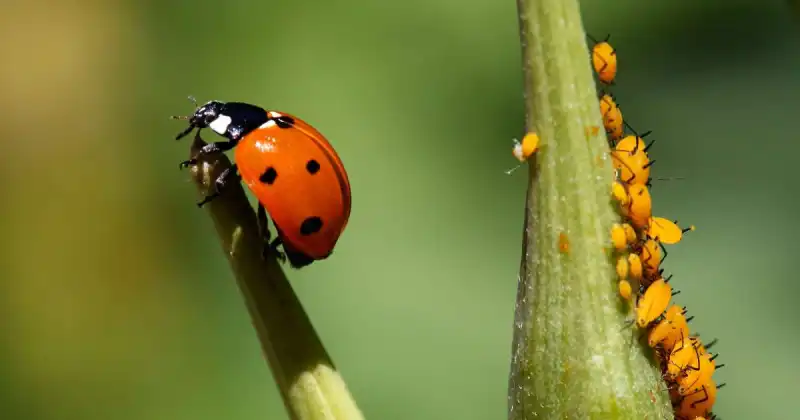
- Ladybugs can eat up to 75 aphids daily. Due to the high number of bugs consumed, lady beetles are excellent natural predators for aphid control in large and small gardens.
- Ladybugs feed on aphid eggs. Because ladybirds also feed on eggs, the breeding cycle of aphids is interrupted. 3
- Ladybug larvae feed on aphids.
- Large aphid infestations call for a large number of ladybugs. Because aphid colonies can swell rapidly, lady beetles may be unable to keep up with demand if their numbers are too small.
- Release ladybugs into your garden when temperatures are cooler. Cooler temperatures encourage ladybirds to settle in your garden and not fly away to someone else’s.
- Ladybugs are readily available to purchase in garden centers or online retailers.
As you can see, using ladybugs for pest control is a no-brainer, but is it as easy as it seems? The following sections look closely at some of these facts and will help you to get the most out of using your new best friends in your garden.
Will Ladybugs Control Aphids
While ladybugs can help eliminate an active aphid infestation and lessen the chances of future ones, releasing a sufficient number of these beetles is vital because their numbers start to decline after 2 or 3 days.
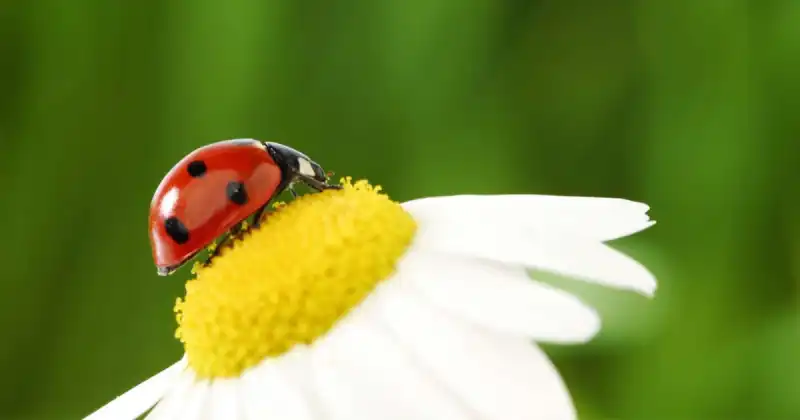
However, if the aphid colony is large enough before they fly off, ladybugs should be able to lay their eggs before they go. And it’s their larvae and subsequent babies that will continue feeding, reducing the aphid population further. 4
How Many Aphids Can A Ladybug Eat
A single ladybug can eat up to 75 aphids in one day. At the same time, their larvae can consume even more, so lady beetles effectively combat swelling aphid colonies that may be threatening your crops. Although many ladybugs can eliminate an active aphid infestation with the proper environmental conditions, these helpful beetles will also lay their eggs, further reducing aphid populations.
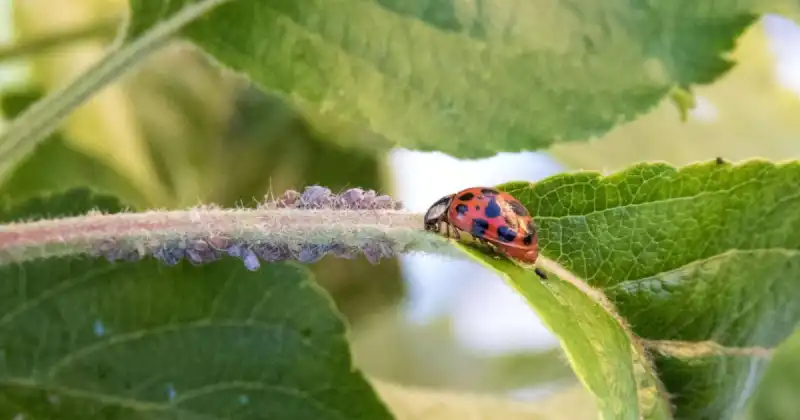
Ladybug eggs hatch after 3 to 10 days, and their hungry larvae will continue to feed on aphids for approximately a month until reaching the pupae stage. Afterward, adult ladybugs emerge from the pupae after about 15 days. Providing sufficient numbers of aphids are still available to feed on, adult ladybugs should remain in your garden for longer, continuing their breeding cycle and further lessening aphid numbers. 5
The video below does an excellent job explaining several strategies for improving the chances ladybugs remain in your garden after their release.
Do Ladybugs Eat Aphid Eggs
Another reason why ladybugs are so effective at controlling aphid infestations is because they eat their eggs, effectively interrupting their generational cycles. When a ladybug finds an aphid colony, it will devour the adult aphids and their eggs. This process is crucial for any grower because it stops the aphid population from spreading to other parts of your garden.
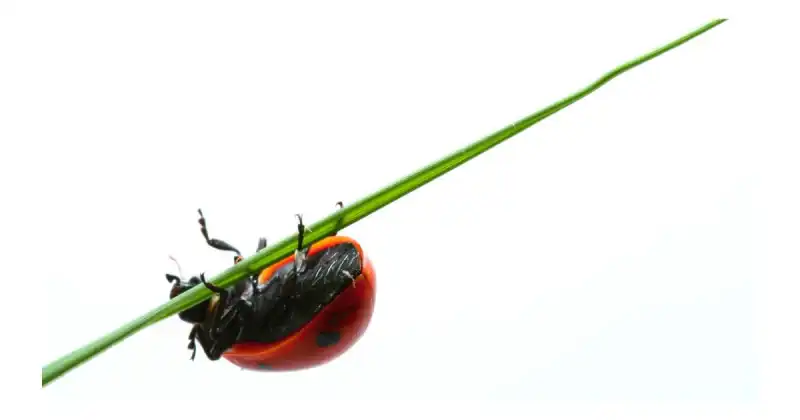
However, not all species of aphids lay eggs. Curiously, during the warm summer months, wingless aphid females give birth to live young without needing a male. As a result, a female can produce up to a staggering 15 generations in a single season, making aphids one of the most reproductive and damaging pests you can encounter.
As temperatures cool during fall, female aphids resume laying eggs on plants that stay dormant through the winter months. If not addressed, these eggs will hatch in early spring, making this an ideal time for ladybugs to get to work. 6
How Many Ladybugs Are Needed To Control An Aphid Infestation
The number of ladybugs it takes to control your aphid challenges depends on the infestation’s severity and the garden’s size. For example, one study by the University of California demonstrated that two separate releases of 1500 ladybugs were required to clear a heavy aphid infestation on a large rose bush.

Therefore, if you’re dealing with a stubborn aphid infestation, knowing how many lady beetles you need to release to control the problem effectively may be helpful. However, it’s not always easy to understand how many beetles you’ll need to clear your colonies until you see decreasing numbers of aphids.
There are several factors at play in achieving the perfect ladybird release. The more beetles you can entice to remain within your garden at the initial release, the fewer you’ll need to get the aphid numbers back to more manageable levels. However, as a general rule, you must release many ladybugs to control even moderately active aphid infestations effectively.
Here are three fundamental conditions to keep in mind when determining how many ladybugs you need to control an aphid infestation in your backyard garden:
- Although recommendations vary widely, an average of 2 ladybugs per square foot of garden area is required. Nearly 95% of ladybugs fly away before settling. Again this shouldn’t alarm you, as this is just beetles’ natural and biological tendencies. Therefore, always aim to release large numbers of ladybugs. Fortunately, when purchasing ladybugs, many companies offer boxes of 500, 1000, or 1500 or more, which should be more than enough to help lessen aphid numbers. 7
- It’s vital to release ladybugs at the right time when aphids are active and present in your garden. Releasing beetles into your growing space as a preventative measure won’t work. Ladybugs need abundant and continual food sources to tempt them to stick around. So if the developing aphid colony isn’t worth their while, lady beetles are likely to leave.
- When releasing your speckled friends throughout your garden, you’ll want to do so as close to the plants with the active aphid infestation as possible to ensure they find their food source quickly. Nothing frustrates a ladybug faster than not knowing if a viable food source is nearby. Therefore, you’ll want to do everything you can to help.
Remember, ladybugs are a great natural solution for controlling aphids, but you need to release enough to impact swelling aphid colonies in your garden.
Benefits Of Using Ladybugs For Pest Control
While synthetic insecticides can harm plants and soil, ladybugs are a great natural alternative with many benefits. There are several fundamental advantages of using ladybugs for natural pest control in your backyard garden, including:
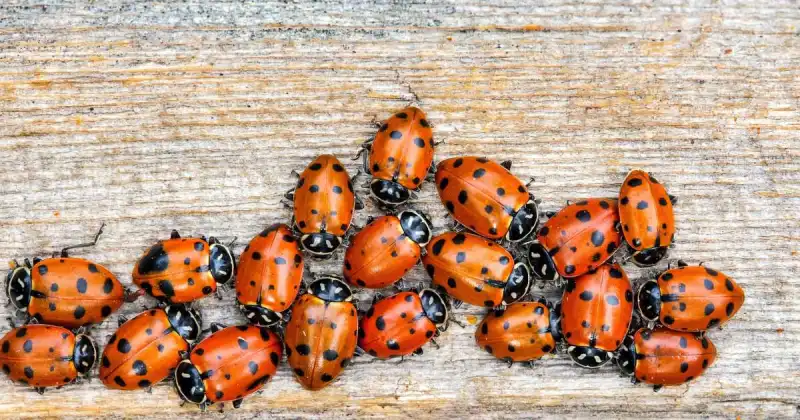
- Natural pest control. Ladybugs are natural predators of many garden pests, including aphids, spider mites, and whiteflies. By releasing beneficial ladybugs into your garden, you can reduce or even eliminate the need for harmful chemicals.
- Cost-effective. Saving money is always on the mind of a prudent gardener, and purchasing ladybugs is a relatively inexpensive way to control annual garden pests.
- Easy to use. Releasing ladybugs is a straightforward process anyone can do. Choose to release your beetles either in the morning or evening, when temperatures have cooled and in areas suffering the worst from the aphid infestation. Consider getting the whole family involved for a fun and educational moment. 8
- Safe for the environment. Unlike chemical pesticides and insecticides, ladybugs are a safe and environmentally friendly option. These friendly beetles won’t harm other beneficial insects, pollinators, or animals. Likewise, they won’t bite humans or leave harmful residues on plants or soil. Sounds like all wins to me!
- Improved plant health. By controlling pests, lady beetles help improve your garden’s overall health and productivity, meaning more productive harvests with bigger, healthier vegetables.
Even with the large volume of aphids each ladybug can consume daily, if their numbers don’t significantly drop, other options may need to be considered to save the health and productivity of your garden. Therefore, with all these beautiful creatures’ benefits to your green space, pesticides, and insecticides may need to be regarded as a last resort.
Drawbacks Of Using Ladybugs For Pest Control
Like most things, using ladybugs for pest control has minor drawbacks. The main disadvantage of using ladybugs is that they may only stay in your garden briefly. Ladybugs are known to fly away within a few days, and even with a well-controlled release, they may not stick around long enough to reduce aphid numbers and provide any significant impact effectively.
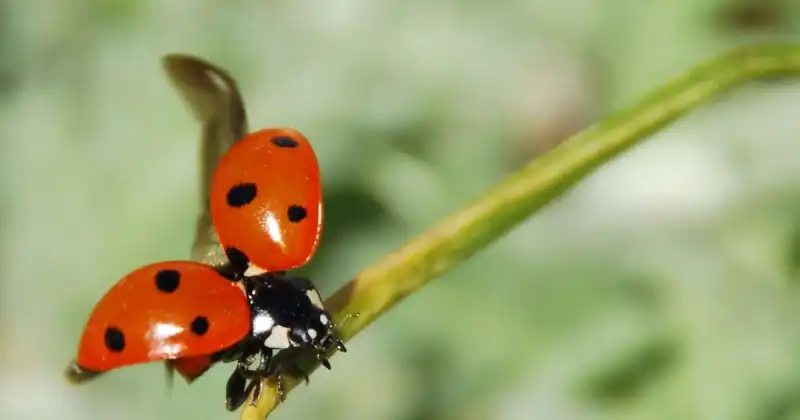
Another downside of using ladybugs is that estimating the number of ladybugs needed to control aphid populations in a small garden can take time and effort. And you’re better off investing in more ladybugs than you need. 9
The easiest way to address these issues is to buy healthy ladybugs, learn how to keep them healthy during storage, and follow the best methods for a controlled release, which we’ll cover below. Ladybugs must also be handled and stored carefully before they are released, or they may not be as effective in controlling pest populations.
How To Release Ladybugs In The Garden
If you want your ladybugs to impact your aphid problem positively, you must release them correctly. You will want to release your ladybugs at the right time of day and in sufficient numbers for adequate control. Assume that up to 95% or more will fly away quickly without affecting your aphid infestation. Those that remain will likely feed and breed, helping to curb aphid numbers and bring a more long-term solution.
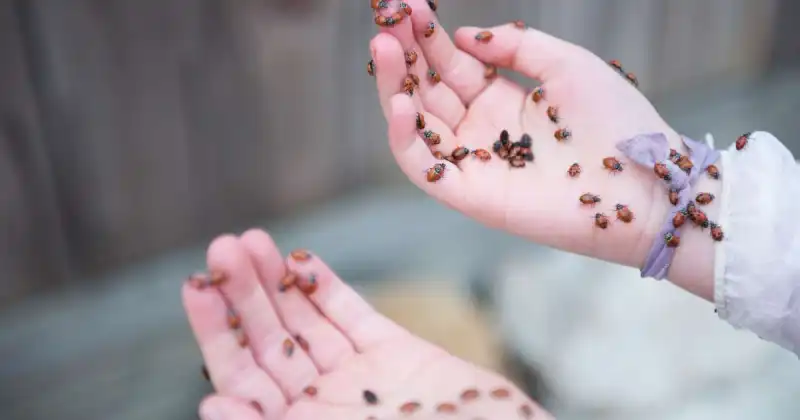
Ensure your garden is suitable for ladybugs by providing various plants and flowers that produce the nectar they need for reproduction. Incorporating a diverse and unique variety of plants, like cilantro, dill, cosmos, and sunflowers, and strategically placing them throughout your green space increases the chances of these little red beetles sticking around. 10
There is growing concern today that aphids and other insects are becoming more resistant to the commercial and indiscriminate use of chemical insecticides and pesticides. Most backyard growers prefer organic, holistic, and naturally sustaining methods to keep their vegetable plants happy, and releasing and allowing ladybugs into your garden is one such effective technique.
How To Make Ladybugs Stay In Your Garden
To achieve a successful ladybug release and to encourage them to remain among your plants, there are several things to consider and steps that you should take, including:
- Step 1
Identify the main areas of your garden where aphid populations are highest. Add some nectar-producing flowers or plants, like sunflowers or cosmos, nearby to encourage the breeding of the ladybugs once they are released.
- Step 2
Purchase ladybugs from a reputable supplier. It is important to note that ladybugs may not be available year-round, so it is best to plan accordingly.
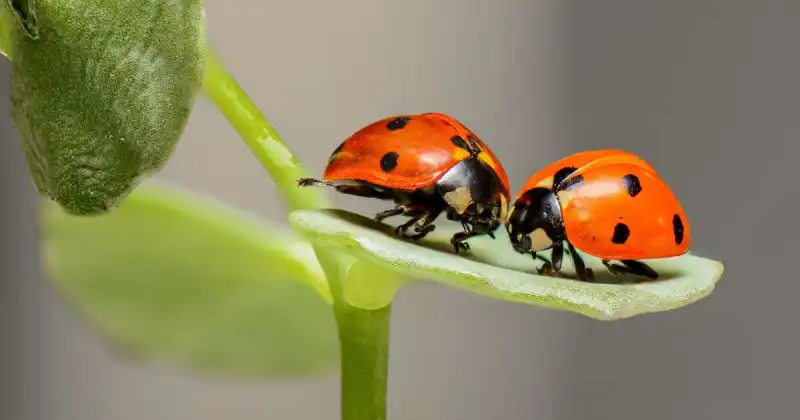
- Step 3
Choose an appropriate time of day to release ladybugs. The best time is early morning or evening when temperatures have cooled, and the bugs are less active and less likely to fly off quickly.
- Step 4
Water the garden before releasing the ladybugs. This extra moisture provides ladybirds hydration and encourages them to stay in the area.
One of the most challenging aspects of releasing lady beetles into your garden is that most will fly away. As a responsible grower, you’ll want to do everything possible to retain these flashy red beetles. This video discusses the three best ways to encourage beetles to stay and continue to protect your garden from swelling aphid numbers.
- Step 5
Release the ladybugs as near the infested plants as possible. It is crucial to spread your beetles evenly so they have a better chance of finding their prey. It’s also good practice to release ladybugs at the base, where they will climb up through the plants to encounter aphids.
- Step 6
Avoid releasing the ladybugs during windy or rainy conditions, as they may be blown or washed away. Waiting for a calmer day motivates beetles to hang around a bit.

- Step 7
After their initial release, monitor the ladybug population for a few days to ensure they are settling in and starting to feed on the aphids. If you discover most or all have flown away, add another round of beetles to your garden.
- Step 8
As previously mentioned, avoid using pesticides or insecticides on the garden immediately before or after releasing the ladybugs, as these harsh chemicals can not only negate their effectiveness but downright kill your newfound friends. 11
- Step 9
If the aphid infestation persists, repeat the ladybug release process as necessary.
Where Can You Buy Ladybugs
Ladybugs are often sold online or in local retail nurseries and garden centers in packages usually containing a specific number, like 500, 1000, or 1500. Packages typically include instructions on how to release the ladybugs and how to care for them in the interim. Some stores and online retailers may also offer ladybugs in bulk, allowing you to purchase larger quantities.
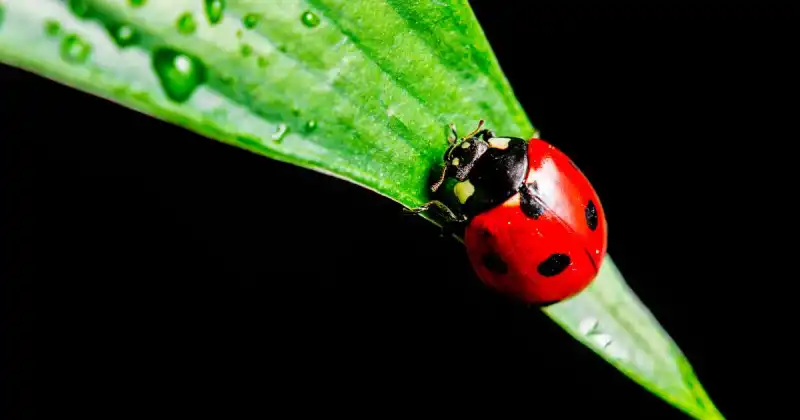
When purchasing ladybugs, ensuring they’re healthy and active is essential. Look for ladybugs moving around with bright, vibrant colors to gauge the colony’s health. Avoid buying ladybugs that appear sluggish or lethargic, as they may not be as effective in controlling aphids. 12
Once you have purchased your lady beetles, it may be appropriate to wait to release them, depending on the weather and other factors that may blunt their initial effectiveness. But with proper care and handling, it’s possible to store them safely until the perfect conditions arise.
How To Store Ladybugs
Properly storing ladybugs is crucial for their effectiveness in controlling pests in your garden. Ladybugs should be refrigerated until ready for release into your garden, as their health may quickly deteriorate when left at indoor room temperatures. You’ll want to handle them carefully because ladybugs aren’t accustomed to indoor settings.
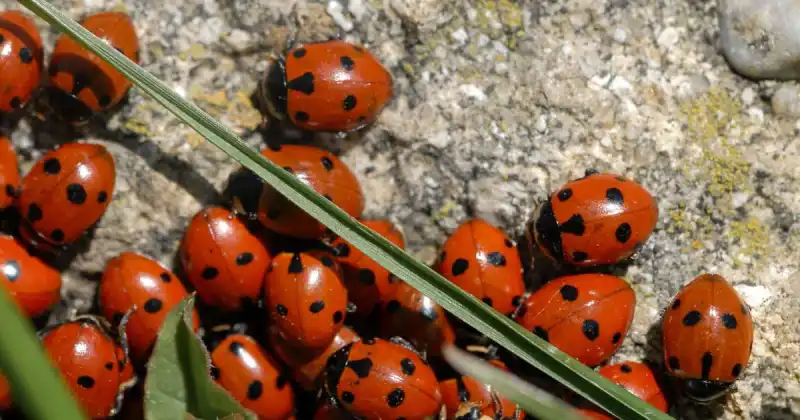
Keeping your lady beetles cool and moist during storage is most important so they stay alive and healthy. When you’re ready to release your ladybugs, do so on a calm day, at dawn or dusk, and follow my steps in the previous section. 13
Consider misting your lady beetles frequently with water while in storage to keep them hydrated, but don’t allow water to form puddles in the container. Placing a slightly damp kitchen towel in the base of the container will also keep them cool and provide shelter.
How Long Can You Keep Ladybugs In The Refrigerator
Ladybugs can be kept in the refrigerator for up to two weeks. However, under the best circumstances, they may last for one to three months if kept between 35°F and 45°F and provided with a sugar water solution for nutrition. If you intend on keeping your ladybugs for extended periods before releasing them, ensure their container has holes large enough for air to circulate. You’ll also not want to overcrowd them, which can cause them to overheat and suffocate.
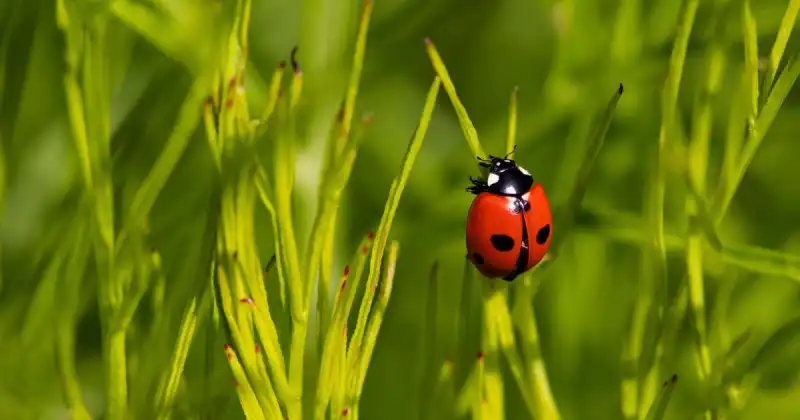
When ladybugs are kept cold, they become less active, often appearing dead in this semi-hibernation state. Once removed from the fridge, they will be starving and thirsty, and a sugar water solution should be adequate to wake them up before release.
Remember, the longer ladybugs are stored, the less effective they will be in controlling your backyard pest challenges. However, keeping them in large numbers does provide the distinct advantage of creating multiple releases over a more extended period and is something to consider if your aphid infestation is swelling. 14
Do Ladybugs Eat Plants
One of the best reasons ladybugs are so good for your backyard green space is that they eat many pests without harming plants. And while a few ladybug species will eat plants, they are uncommon. The biggest threat ladybugs pose to plants is spreading diseases from nearby plants. However, this happens naturally with all garden insects and is unavoidable when working with Mother Nature.

The benefits of having these primarily carnivorous insects far outweigh any problems they will cause, so you can be safe knowing that the more lady beetles you can attract to your garden, the healthier your plants will be. 15
Conclusion
Ladybugs are an effective and natural option for aphid control. Although they may not completely solve your pest problem, they can significantly impact aphid colonies and their breeding habits and preserve your garden’s health and vitality. Lady beetles are both effective in their adult form and as larvae, making them an excellent predators for the notorious aphid.
Using ladybugs for pest control has many benefits, such as being environmentally friendly and reducing the need for harsh chemical insecticides and pesticides. However, it’s essential to consider the drawbacks, such as the potential for ladybugs to fly away or not eat all the aphids encroaching on your green turf.
If you decide to release ladybugs in your garden, follow the proper steps for storage and release, including releasing your beetles at dawn or dusk, watering your garden beforehand, and ensuring the weather is calm when spreading them within your garden space.
Remember, releasing ladybugs in your garden does not guarantee they will eat all the aphids or even remain in your garden. However, it provides an excellent opportunity to use a natural pest control option, without chemicals, for those looking for an environmentally friendly and effective solution. With proper timing, storage, and release rates, ladybugs can be a valuable strategy for your pest control arsenal.
Have you used ladybugs to effectively fight back against invading aphids? We’d love to know your story and exactly how you did it! Meet us in the comments below and let us know about your success.
SOURCES
- National Library Of Medicine, National Center For Biotechnology Information – Insights Into Aphid Prey Consumption By Ladybirds: Optimising Field Sampling Methods And Primer Design For High Throughput Sequencing
- University Of Florida, Entomolgy & Nematology – Common Name: Ladybirds, Lady Beetles, Ladybugs [Of Florida] Scientific Name: (Insecta: Coleoptera: Coccinellidae)
- University Of Kentucky, Urban Forest Initiative – A Good Spring For Aphids
- Pollinator.org – Pollinators Need You. You Need Pollinators
- National Library Of Medicine, National Center For Biotechnology Information – Insights Into The Effects Of Insecticidese On Aphids (Hemiptera: Aphididae): Resistance Mechanisms And Molecular Basis
- Penn State University, Extension – Less Harmful Pesticides
- University Of Minnesota, Extension – Aphids In Home Yards And Gardens
- University Of California, Agriculture And Natural Resources – Lady Bugs Need Special Care To Control Aphids In The Garden
- North Carolina State University, Extension – Ladybugs On The Prowl!
- Wikipedia – Coccinellidae
- University Of California, Agriculture And Natural Resources – Ladybugs Are Good For Your Garden
- ResearchGate – Food Habits Or Preferences And Protecting Or Encouraging Of Native Ladybugs (Coleoptera: Coccinellidae)
- National Library Of Medicine, National Center For Biotechnology Information – Storage Potential Of The Predatory Ladybird Cheilomenes Propinqua In Relation To Temperature, Humidity, And Factitious Food
- National Park Service – Ladybug
- Oxford Academic Journal Of Experimental Botany – Interplay Between Insects And Plants: Dynamic And Complex Interactions That Have Coevolved Over Millions Of Years But Act In Milliseconds


